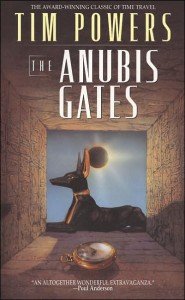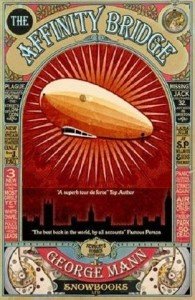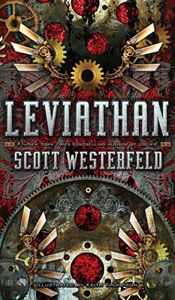At the end of 2010 a vivid debate began on the present and future of steampunk on the blogs of American SF-authors and the bigger sites related to the topic. One of the comments taken from the heated conversation sums up the controversy really nicely: “Steampunk? That’s so 2008!” Let’s see what we the fuss was all about. [Editor’s note: the original Hungarian article was published in 2011.]
Hungarian science-fiction publishing still owes us the books by Charles Stross, so his name might not be as familiar in Hungary as he should be, but the renowned author writes an immensely popular blog where he often discusses subjects which are currently debated. So it was not entirely suprising that he caused quite a stir last year among authors and readers when he wrote a criticising post on the presently peaking steampunk-fad.
The full post by Stross – with the very edifying comments – can be read on the author’s blog (Thehardedgeofempire). There is no point in going through all of the writer’s comments step by step, although it offers several interesting points in itself. Has steampunk really lost all of its sci-fi elements with the loss of scientism (or has steampunk ever expressed the need to be scientifically accurate?). Does it really idolizes an oppressive social system and builds a romantic dream world from a cruel era? However, in Hungary, where (with some slight exaggeration) we can count the steampunk stories translated to or written in Hungarian on one hand, the debate-starting question of Stross becomes way more interesting, because he thinks that soon there will be more than enough steampunk novels and this trend slowly becomes way too uninteresting.
At first sight, the problem is very interesting: have we really had it with steampunk? The people who have been keeping track of the history of the subgenre can remember that the publication of a steampunk-themed writing was considered a real surprise in the nineties. To tell you the truth, I was hooked after reading The Difference Engine by Gibson and Sterling even back than (it was published in Hungarian, but only years later), and as soon as I collected the stories that began this trend (such as Morlock Night by K. W. Jeter, The Anubis Gates by Tim Powers or Warlord of the Air by Moorcock), I could only choose from a much slimmer selection – The Steampunk Trilogy by Paul DiFilippo, Pasquale’s Angel by Paul J. McAuley, and I can’t think of any more names right now.
Approximately in the middle of the nineties, steam began to leak into the realm of fantasy – the novel Silverheart by Moorcock and Storm and the encyclopaedia-sized novel which is Perdido Street Station by China Miéville are the best examples –, to computer games (Arcanum), comic books (The League of Extraordinary Gentlemen by Alan Moore). Then it looked like that the energy which was constantly building up suddenly vanished, and steampunk remained to be a hobby for only a limited number of fans. Maybe role playing games were the ones which swooped down on steampunk in the most innovative way, and the industrial Middle Age of Iron Kingdoms or the fantasy setting of Dragonmech with its steam-powered robots brought out a lot of things from this topic, yet they never became well-known for a broader audience.
Yet something finally changed around the second half of the 2000s. All of a sudden, steampunk became visible again, and not in a very subtle way. In hindsight, it’s hard to tell how this trend began: laptop-modding with wooden keyboards and copper mountings, steampunk jewellery, clothes and glasses made of smoked glass? When venturesomeartists reimagined classics like Star Wars steampunk-style? At the premiere of the steampunk-styled, big budget anime Steamboy? In my opinion – and please feel free to argue –, this second return of steampunk (I avoided using the term “renaissance” on purpose) is caused by the f
act that it is, basically, a visually spectacular media, and it is obvious that it is way more effective to show the enormous machines or gadgets rather than tell read about them, and this way it greaches an even broader audience.
And the steam-engine of related literature spluttered into life again. No explanation was required anymore on the attractiveness of the genre, since it was visible for anybody who liked fantastic machinery, airships or top-hats. Steampunk became more and more popular.
Of course, popularity is a relative concept. Thankfully, steampunk (for the time being) did not share the same sad fate as vampires and werewolves, namely becoming the cheesy-romantic parodies of their former selves. Yet based on its former fame it is undeniably a great jump when a popular crime series that lacks any kinds of fantasy elements – such as the tv-series Castle – uses the steampunk subculture or the appearance of the “parasols and steampunk”-type romantic novels (GailCarriger – Soulless).
Before going any further, I’d like to be clear on one thing: from now on, when I’m trying to discuss the exhaustion of the steampunk genre, I’m only talking about works of literature. I cannot judge the current state of the steampunk movies, anime, jewellery makers, dress-designers, virtual and non-virtual communities, etc, so I can’t make a well-based opinion on whether these are influenced by the problems of the steampunk literature, which grew way too big and it is slowly about to burst.
The first phase of the upswing began around 2008 and 2009, when the first novels promoted specifically as steampunk novels were published, and the marketing was not too small, either. The Internetpage of Tor publishing house shared a great deal of this, and they put a lot of effort into this trend: thematic steampunk weeks, continuous articles, and they have been collecting the news on this topic in theme-specific Twitterchannel and Facebookgroup ever since. And the news just keep coming every day: the steampunk community is in an uproar, and the publications just keep coming.
The first novel which was met with serious publicity and positive reviews was TheAffinity Bridge by George Mann. At the first glance, it is an absolutely sympathetic enterprise: it’s basically a Sherlock Holmes-story set in a steampunk London, where Queen Victoria’s agent, Maurice Newbury plays the role of the detective, and the expeditious Miss Hobbes acts like a female Watson. Unfortunately the positive impressions do not last until the end of the novel. Mann did not write a bad book, it’s just that there is nothing new in it – the London we meet is similar to the one we read about in Gibson and Sterling’s The Difference Engine, but that was more ingenious, darker and more realistic. Mann’s novel is a great pick for those who are just getting familiar with the genre, but readers who have already finished at least one steampunk novel are not going to find anything particularly new here. Mann – maybe because of the reasons I mentioned – tries to introduce new ideas by bringing in an occult plot with zombies and ghosts, but in the first book of a planned series their presence only serve as a promise of more interesting things to come. To sum it all up: a solid book with well-known material without any sense of novelty.
The novel Boneshaker by Cherie Priest tries to break free of clichés in several
different ways, and i’s off to a good start. The book is set in Seattle in the middle of the 19th century (instead of the usual smog-filled, Victorian London), where the machine built by a crazy inventor causes a massive disaster, and the killing gas steaming up from the bowels of the Earth turns people into zombies. The upbeat is clever, everything is given to name this book as the reformatory novel of the genre, and the immensely positive critical reception supports our claim. It was probably just me, but I found Priest’s novel somewhat slow and not too fascinating. Probably I would have loved it if it had been a movie, a comic book or a videogame: the post-apocalyptic Seattle surrounded by a wall, zombie hordes roaming the streets, steampunk gadgets and airships, the adventurers in the gas masks, the alternative civil war could jump-start the imagination of the former fans of the genre. The problem is that everything which could be really exciting in a movie – escape from the zombies, the fight between survivors and looters – seemed like out of place in a book – well, at least for me. Which is a pity, since the world-building itself evokes that particular freshness that has been lacking from other current books of the genre.
The third important novel is Leviathan by Scott Westerfeld, the first book of a young adult series, but it is entertaining for adult audiences, too. The story is set in an alternative Europe, just before the beginning of World War I, where the Prussian Empire, armed with steam mechas, stands against the British Empire and its creatures engineered by Darwinistic principles. Interestingly enough it was the great ideas of Leviathan that made it clear for me that this genre ran out of ideas. What Priest could not achieve (with me) with his zombies, Westerfeld could do it with his Darwinists, so he developed steampunk even further with a new and clever method. The smoking, steam-powered walkers looked like ancient relics compared to the giant, living airships, and I was always looking forward to read more about the Darwinists.
This is where we are now. It looks like that everything that made steampunk exciting at the beginning has slowly turned into a cliché by now, and it is clear that putting steam engines, foggy London and the complimentary airship into a novel is not enough anymore. Westerfeld’s example proves that changing things is not impossible, but during this incredibly energetic wave, it is hard to spot the novelty. The trend raised Priest’s book on its shoulder, and we can expect many more of the zombies and airships, airships and Wild West, steam and romance type of novels – which is going to push steampunk towards the path Stross mentioned and cyberpunk once had to pass.
Somewhere it makes sense why this genre got into a dead end. Making something different from the well-known basic material is a great risk of changes. If Westerfeld would have omitted the steam walkers, Leviathan would have become a completely different book. The subtypes rooted in steampunk tend to become separate subcategories, like clockpunk based on windup gadgets (Jay Lake: Mainspring) or dieselpunk, which puts twentieth-century machinery into an alternative history.
The other solution could be what Priest attempted: change the scenery. The debate-starter by Stross moved African steampunk into the limelight, and the World SF blog wrote about anIslamicsteampunk novel currently in progress. The newest novel of French author Jean-Christophe Valtat, Aurorarama – the story of New Venice built under the ice of the North Pole from around 1908 – seems like an interesting contestant.
And if we are talking about leaving the well-known area behind us, then we are on the right spot in Hungary. Since every cloud has a silver lining, we can relax for now: no, we are not threatened by getting swamped with steampunk novels. Some of the classics available to Hungarian audiences are The Difference Engine and The Anubis Gates by Tim Powers, which is considered to be one of the first steampunk novels, but those who expect the usual airships and steam engines will be disappointed. If we wanted to discuss the steampunk stories of Hungarian authors, we would be restricted to an equally short list of titles. The novel Mars 1910 by W. Hamilton Green (Zoltán Galántai) was published in the nineties, and since then only one short story (Parallels in Infinity by Zoltán László, Metagalaktika vol. 11) has been close to the alternative realities discussed above, and maybe the occasional mix of steampunk and fantasy in certain stories set in the M. A. G. U. S universe.
Currently it’s very hard to form an opinion of the longevity of steampunk literature. Is this really the beginning of true popularity for a genre, or everything will go downhill very soon? Only time will tell.
Recommended links:
In case you are interested in the feedback of the debate-inducing article of Charles Stross, you should browse the following pages:
● Catherynne M. Valente – “I’msicktodeathofsteampunk”
● The Caribbean-born SF-writer, Tobias Buckell examinesthesituationfromadifferentpointofview
● Nisi Shawl of Tor.com gives yetanotheropinion on the problem
● The author of Aurorarama defendsthehonourofsteampunk on the site io9
Viktor Juhász
Translated by Ferenc Benkő
A cikk magyarul az alábbi linken olvasható: http://sfmag.hu/2011/03/23/a-steampunkbol-lassan-kifogy-a-goz/
Hozzászólások
[juhaszviktor további írásai]






A cikk első megjelenése óta futottam bele Mark Hodder könyvébe: The Strange Affair of Spring Heeled Jack. Ez győzött meg arról, hogy még nem mondták ki az utolsó szót sztímpánk-ügyben.